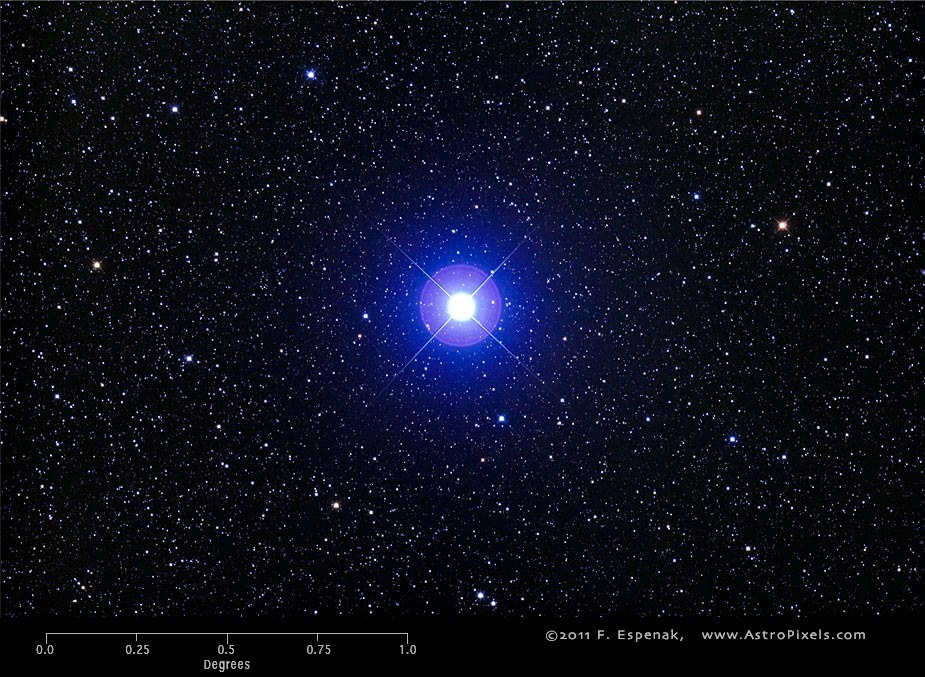Vega
Vega or Alpha Lyrae (Alp Lyr) is the brightest naked eye star in the constellation Lyra. With an apparent magnitude of 0.03v, Vega is the 5th brightest star in the entire sky (see: 50 Brightest Stars ). Its absolute magnitude is 0.58 and its distance is 25.3 light years. The Equinox J2000 equatorial coordinates are RA = 18h 36m 56.3s, Dec = +38° 47' 01".
Vega has a spectral type of A0V, a surface temperature of 9600° Kelvin and a luminosity 37 times the Sun. It has a mass of 2.1 solar masses and a diameter 2.3 times the Sun.
The image above shows the uncropped view of Vega (North is up) through the Takahashi E-180 Astrograph.
Vega is a relatively close star at only 25 light years from Earth. Together with Arcturus and Sirius, it one of the most luminous stars in the Sun's neighborhood. Vega is one of the vertices of the Summer Triangle along with Deneb, and Altair. As such it is high in the sky most of the night during the summer months.
Vega's spectral class is A0V, making it a blue-tinged white main sequence star that is fusing hydrogen to helium in its core. Its current age is about 455 million years. Vega is only about a tenth of the age of the Sun, but since it is 2.1 times as massive its expected lifetime is also one tenth of that of the Sun. Both stars are presently approaching the midpoint of their life expectancies. Vega has an unusually low abundance of the elements with a higher atomic number than that of helium.
Vega is also a suspected variable star that may vary slightly in magnitude in a periodic manner. It is rotating rapidly with a velocity of 274 km/s at the equator. This causing the equator to bulge outward because of centrifugal effects, and, as a result, there is a variation of temperature across the star's photosphere that reaches a maximum at the poles. From Earth, Vega is being observed from the direction of one of these poles.
Based on an observed excess emission of infrared radiation, Vega appears to have a circumstellar disk of dust. This dust is likely to be the result of collisions between objects in an orbiting debris disk, which is analogous to the Kuiper belt in the Solar System. Stars that display an infrared excess because of dust emission are termed Vega-like stars. Irregularities in Vega's disk also suggest the presence of at least one planet about the size of Jupiter.
Vega has been extensively studied by astronomers, leading it to be termed "arguably the next most important star in the sky after the Sun." It was the northern pole star around 12,000 BCE and will be so again around 13,700 CE. Vega was the first star (other than the Sun) to be photographed and the first to have its spectrum recorded. It was also one of the first stars whose distance was estimated through parallax measurements.
The description above is based on the Vega entry in Wikipedia. For more information about Vega, see Stars (Jim Kaler).
Technical Details
- Object: Vega
- Other Names: Alpha Lyrae, HR7001, HD172167, HIP91262
- Object Type: bright star
- Object Data: Apparent Magnitude = 0.03v, Absolute Magnitude = 0.58, distance = 25.3 light years
- Object Position (Equinox J2000): RA = 18h 36m 56.3s, Dec = +38° 47' 01", Constellation = Lyra
- Date/Time: 2011 Oct 21 at 03:32:31 UTC
- Location: Bifrost Astronomical Observatory, Portal, AZ
- Mount: Astro-Physics 1200GTO
- Telescope: Takahashi Epsilon 180 Hyperbolic Astrograph
- Camera: Canon EOS 550D (Rebel T2i) (modified with a Baader UV/IR filter)
- Field of View: 1.70° x 2.56° at 1.7 arc-sec/pixel (web version: 10.0 arc-sec/pixel)
- Exposure: 2 x 300s, f/2.8, ISO 800
- File Name: Vega-01w.jpg
- Processing (Adobe Camera Raw): Graduated Filter, Vignetting Correction, Noise Reduction, White Balance, Curves
- Processing (Photoshop CS5): Average Images, Curves, Noise Reduction
- Original Image Size: 3454 × 5179 pixels (17.9 MP); 11.5" x 17.3" @ 300 dpi
- Rights: Copyright 2011 by Fred Espenak. All Rights Reserved. See: Image Licensing.
